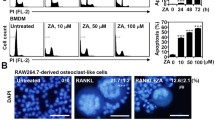Abstract
Ascorbic acid (AA) plays a key role in the regulation of differentiation and activation of osteoclast (OCL). It was reported that AA might induce the formation of OCL in co-cultures of mouse bone marrow cells and ST2 cells, but it is not clear whether AA has a direct impact on the OCL precursors. The purpose of this study was to examine the effect of AA on the differentiation of OCL precursor RAW264.7 cells, cultured with receptor-activated nuclear factor kappaB ligand (RANKL). The results showed that AA remarkably inhibited the cell proliferation at a higher concentration and RANKL alone is sufficient for osteoclastogenesis. The expression of carbonic anhydrase (CAII) mRNA and protein, the number of tartrate-resistant acid phosphatase (TRAP)-positive multinucleated cells (MNCs), and the percentage area of resorption lacunae induced by RANKL were decreased when AA was added to the cultures. The results demonstrate that AA inhibits RANKL-induced differentiation of OCL precursor cells into mature OCL and reduces the formation of bone resorption pits in vitro.
Similar content being viewed by others
References
Lacey DL, Timms E, Tan H, et al. Osteoprotegerin ligand is a cytokine that regulates osteoclast differentiation and activation. Cell 1998, 93: 165–76.
Yasuda H, Shima N, Nakagawa N, et al. Osteoclast differentiation factor is a ligand for osteoprotegerin/osteoclastogenesisinhibitory factor and identical to TRANCE/RANKL. Proc Natl Acad Sci USA 1998, 95: 3597–602.
Hirotani H, Tuohy NA, Woo JT, Stern PH, Clipstone NA. The calcineurin/NFAT signalling pathway regulates osteoclastogenesis in RAW264.7 cells. J Biol Chem 2004, 279: 13984–92.
Morton DJ, Barrett-Connor EL, Schneider DL. Vitamin C supplement use and bone mineral density in postmenopausal women. J Bone Miner Res 2001, 16: 135–40.
Otsuka E, Kato Y, Hirose S, Hagiwara H. Role of ascorbic acid in the osteoclast formation: induction of osteoclast differentiation factor with formation of the extracellular collagen matrix. Endocrinology 2000, 141: 3006–11.
Udagawa N, Takahashi N, Akatsu T, et al. Oringin of osteoclasts: mature monocytes and macrophages are capable of differentiating into osteoclasts under a suitable microenvironment prepared by bone marrow-derived stromal cells. Proc Natl Acad Sci USA 1990, 87: 7260–4.
Ragab AA, Lavish SA, Banks MA, Goldberg VM, Greenfield EM. Osteoclast differentiation requires ascorbic acid. J Bone Miner Res 1998, 13: 970–7.
Chin SL, Johnson SA, Quinn J, et al. A role for a integrin subunit in TGF-b stimulated osteoclastogenesis. Biochem Biophys Res Commun 2003, 307: 1051–8.
Bharti AC, Takada Y, Shishodia S, Aggarwal BB. Evidence that receptor activator of nuclear factor (NF)-kappaB ligand can suppress cell proliferation and induce apoptosis through activation of a NF-kappaB-independent and TRAF6-dependent mechanism. J Biol Chem 2004, 279: 6065–76.
Mukhopadhyay D, Sundereshan S, Rao C, Karande AA. Placental protein 14 induces apaptosis in T cells but not in monocytes. J Biol Chem 2001, 276: 28268–73.
Choi Y, Woo KM, Ko SH, et al. Osteoclastogenesis is enhanced by activated B cells but suppressed by activated CD8(+) T cells. Eur J Immunol 2001, 31: 2179–88.
Taylor MD, Roberts JR, Hubbs AF, Reasor MJ, Antonini JM. Quantitative image analysis of drug-induced lung fibrosis using laser scanning confocal microscopy. Toxicol Sci 2002, 67: 295–302.
Shevde NK, Bendixen AC, Dienger KM, Pike JW. Estrogens suppress RANK ligand-induced osteoclast differentiation via a stromal cell independent mechanism involving c-Jun repression. Proc Natl Acad Sci 2000, 97: 7829–34.
Naidu KA. Vitamin C in human health and disease is still a mystery? An overview. Nutr J 2003, 2:7.
Ilich JZ, Brownbill RA, Tamborini L. Bone and nutrition in elderly women: protein, energy, and calcium as main determinants of bone mineral density. Eur J Clin Nutr 2003, 57: 554–65.
Kaptoge S, Welch A, McTaggart A, et al. Effects of dietary nutrients and food groups on bone loss from the proximal femur in men and women in the 7th and 8th decades of age. Osteoporos Int 2003, 14: 418–28.
Bird TA, Schwartz NB, Peterkofsky B. Mechanism for the decreased biosynthesis of cartilage proteoglycan in the scorbutic guinea pig. J Biol Chem 1986, 261: 11166–72.
Goto A, Tsukamoto I. Increase in Tratrate-Resitant Acid Phosphatase of bone at the early stage of ascorbic acid deficiency in the ascorbate-requiring osteogenic disorder Shiongi (ODS) rat. Calcif Tissue Int 2003, 73: 180–5.
Navas P, Villalba JM, Cordoba F. Ascorbate function at the plasma membrane. Biochim Biophys Acta 1994, 1197: 1–13.
Franceschi RT. The role of ascorbic acid in mesenchymal differentiation. Nutr Rev 1992, 50: 65–70.
Suda N, Morita I, Kuroda T, Murota S. Participation of oxidative stress in the process of osteoclast differentiation. Biochim Biophys Acta 1993, 1157: 318–23.
Garrett IR, Boyce BF, Oreffo RO, Bonewald L, Poser J, Mundy GR. Oxygen-derived free radicals stimulate osteoclastic bone resorption in rodent bone in vitro and in vivo. J Clin Invest 1990, 85: 632–9.
Biskobing DM, Fan D. Acid PH increase carbonic anhydrase II and calcitonin receptor mRNA expression in mature osteoclast. Calcif Tissue Int 2000, 67: 178–83.
Author information
Authors and Affiliations
Corresponding author
Rights and permissions
About this article
Cite this article
Xiao, X.H., Liao, E.Y., Zhou, H.D. et al. Ascorbic acid inhibits osteoclastogenesis of RAW264.7 cells induced by receptor activated nuclear factor kappaB ligand (RANKL) in vitro . J Endocrinol Invest 28, 253–260 (2005). https://doi.org/10.1007/BF03345382
Accepted:
Published:
Issue Date:
DOI: https://doi.org/10.1007/BF03345382




